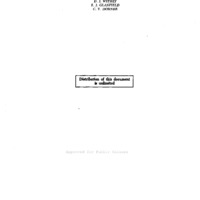-
Title
-
Application of Permselective Composite Techniques for Atmosphere-Thermal Control of Emergency
-
Date
-
1967
-
Index Abstract
-
Not Available
-
Photo Quality
-
Not Needed
-
Report Number
-
AMRL TR 66-224
-
Creator
-
Withey, D. J.
-
Glanfield, E. J.
-
Dohner, C. V.
-
Corporate Author
-
General Electric Company
-
Laboratory
-
Aerospace Medical Research Laboratories
-
Extent
-
94
-
Identifier
-
AD0655089
-
Access Rights
-
Distribution of this document is unlimited
-
Distribution Classification
-
1
-
Contract
-
AF 33(615)-2850
-
DoD Project
-
6373
-
DoD Task
-
637302
-
DTIC Record Exists
-
No
-
Distribution Change Authority Correspondence
-
None
-
Distribution Conflict
-
No
-
Abstract
-
The program encompasses the analysis, research, design fabrication, and testing of an exploratory laboratory model of an emergency or extravehicular space assembly using permselective membrane techniques for atmosphere control. The purpose of this effort was to develop an advanced concept which would depart from the traditional approach utilized in spacecraft design by transferring most of the atmosphere-thermal control functions from the associated hardware subsystems to the enclosing structure. A silicon rubber permselective composite incorporated into the pressure retention wall of the enclosing structure permits selective permeation of carbon dioxide, water vapor, and contaminant gases to space with minimal oxygen permeation. In addition, the use of superinsulation on the exterior surface of the structure provides passive radiant thermal control. This, in conjunction with the permselective composite material, substantially reduces the weight, volume, and power requirements of environmental control subsystems required for a manned emergency and extravehicular assembly. While the permselectivity of the silicone rubber composite was determined, the final structure was subject to a large amount of leakage. This resulted in the cancellation of the full scale test program and in redirection of the project effort to include a failure analysis to determine the cause and solution to the leakage problem.
-
Report Availability
-
Full text available
-
Date Issued
-
1967-04
-
Provenance
-
RAF Centre of Aviation Medicine
-
Type
-
report
-
Format
-
1 online resource
 AMRLTR66-224.pdf
AMRLTR66-224.pdf